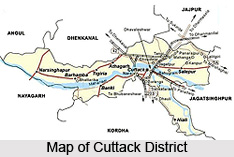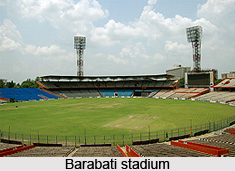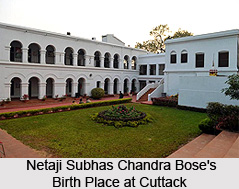 Cuttack District is one of the most important districts in the state of Orissa with its administrative headquarters located at Cuttack city. Legend suggests that the name Cuttack has been derived from the Sanskrit word `Kataka`, which means a military camp or a fort or a government seat, protected by an army. It is one of the oldest cities in India and the business capital of Orissa. Nestled at the land formed by the Mahanadi River in the north and Kathajodi in the south, Cuttack is a picturesque district. The entire district of Cuttack is well connected by railways and the nearest airport is the Biju Patnaik Airport. Cuttack has been enjoying all along the unique privilege of being the administrative and commercial nerve centre of Orissa .It was the seat of the commissioner of Orissa Division till 1936 and with the formation of the province of Orissa in that year it was exalted to be the headquarter of the new province.
Cuttack District is one of the most important districts in the state of Orissa with its administrative headquarters located at Cuttack city. Legend suggests that the name Cuttack has been derived from the Sanskrit word `Kataka`, which means a military camp or a fort or a government seat, protected by an army. It is one of the oldest cities in India and the business capital of Orissa. Nestled at the land formed by the Mahanadi River in the north and Kathajodi in the south, Cuttack is a picturesque district. The entire district of Cuttack is well connected by railways and the nearest airport is the Biju Patnaik Airport. Cuttack has been enjoying all along the unique privilege of being the administrative and commercial nerve centre of Orissa .It was the seat of the commissioner of Orissa Division till 1936 and with the formation of the province of Orissa in that year it was exalted to be the headquarter of the new province.
History of Cuttack District
The history of Cuttack District is associated with the Keshari dynasty. In the remote past Cuttack was connected both by land routes and waterways with the renowned medieval ports like Chelitalo, Palur and Tarmalipti. Although politically Cuttack was not that significant before eight century A.D, but it was a flourishing mart of Eastern trade. However, Cuttack became a capital city as the end of the 10th century A.D during the reign of Somvanshi dynasty of Orissa. History states that the reign of Markata Keshari was distinguished for the construction of the stone embankment to protect the new capital from flood in 1002 A.D. The city of Cuttack started as a military cantonment because of its secure situation that further developed into the capital of the state of Orissa. In 1211, Cuttack became the capital of Anangabhimadeva of the Ganga dynasty. The reference from Ain-i-Akbari clearly denotes that Cuttack was a flourishing capital city during the time of Mukunda Deva. On the eve of Afghan occupation, Cuttack was found as a well guarded and heavily equipped capital.
The importance of Cuttack rapidly increased after the occupation of Orissa by Chohagangadeva early in the 12th century A.D. With the end of the Ganga rule Orissa passed into the hands of the Barabati Fort. By 1750 Cuttack came under the Marathas as it was a vital point of contact between the Marathas of Nagpur and the English merchants of Bengal. During the rule of Marathas, Cuttack greatly prospered as an emporium of trade and commerce. As per the treaty of Deogaon, Cuttack came under British occupation in 1803 and the English set themselves to the task of consolidation and land revenue administration. The British occupied it in 1803 and later it became the capital of Orissa in 1816. After independence in 1948 Bhubaneshwar was made the capital of Orissa although Cuttack continued to remain its administrative head.
Geography of Cuttack District
 Cuttack District is located between 84 degree 58 minutes to 86 degree 20 minutes east longitude and 20 degree 3 minutes to 20 degree 40 minutes north latitude. Covering an area of about 5915 sq km. Cuttack District is located at an altitude of about 15 metres and receives an annual rainfall of about 1443.9 mm. Its climate is hot and humid. During the summer the mercury rises as high as 40 degree Celsius while during the winters temperature falls as low as 10 degree Celsius. Summer starts at the end of March and lasts till June till the monsoons sets in. During the monsoons the city receives an average rainfall of 144.39 cm during September to mid October. Winter season starts from November and lasts till January and is characterised by chill winds from the north. Mid January to mid March is pleasant with moderate climate.
Cuttack District is located between 84 degree 58 minutes to 86 degree 20 minutes east longitude and 20 degree 3 minutes to 20 degree 40 minutes north latitude. Covering an area of about 5915 sq km. Cuttack District is located at an altitude of about 15 metres and receives an annual rainfall of about 1443.9 mm. Its climate is hot and humid. During the summer the mercury rises as high as 40 degree Celsius while during the winters temperature falls as low as 10 degree Celsius. Summer starts at the end of March and lasts till June till the monsoons sets in. During the monsoons the city receives an average rainfall of 144.39 cm during September to mid October. Winter season starts from November and lasts till January and is characterised by chill winds from the north. Mid January to mid March is pleasant with moderate climate.
Administration of Cuttack District
Administration of Cuttack District includes three sub-divisions and these are Cuttack, Athagarh, and Banki. The major development blocks of this district are Choudhar, Salepur, Tigiria, Mahanga, Nichintakoeli, Nima sahi, Damapara, Niali, Narasinghapur, Badampur, Baranga and Kantapara. The major cities around Cuttack are Bhubaneshwar, Puri and Konark.
Education in Cuttack District
Cuttack has many famous educational institutions like the Ravenshaw College, Christ College, Stewart Science College and many more. Ravenshaw College has a prestigious history and is known for producing several top class officials and academicians. Several National research laboratories like the Central Rice Research Institute which is a premier institute of rice research in the whole of South Asia are also located here in Bidyadharpur. Shri Ramachandra Bhanja Medical College and hospital is the largest hospital in Orissa. Further, there are many engineering colleges in Cuttack.

Culture of Cuttack District
Many festivals are celebrated in Cuttack district as well. The important festivals of Cuttack district are Dussehra and Bali Yatra. Dussehra is the festival of Goddess Durga. Baliyatra is the festival of remembering the ancient tradition of trade between Orissa and Java, Bali and Sumatra. It is held every year in the month of November. Among other celebrations the kite flying festival is very much attractive which is held in the month of January. Cuttack district is well known for its filigree works in silver, ivory and brass works. The silk and cotton Sarees of Cuttack known as `Katki are also very famous.
Cuttack District is a place of cricket lovers, which is reflected in the Barabati stadium, which is an important venue for international cricket matches. The remains of the Barabati fort stand near the Barabati stadium.






